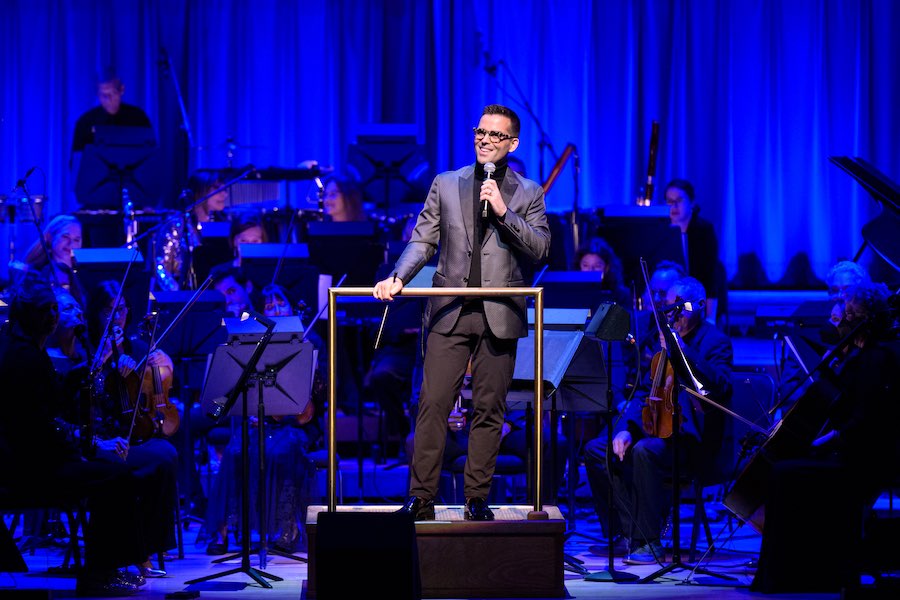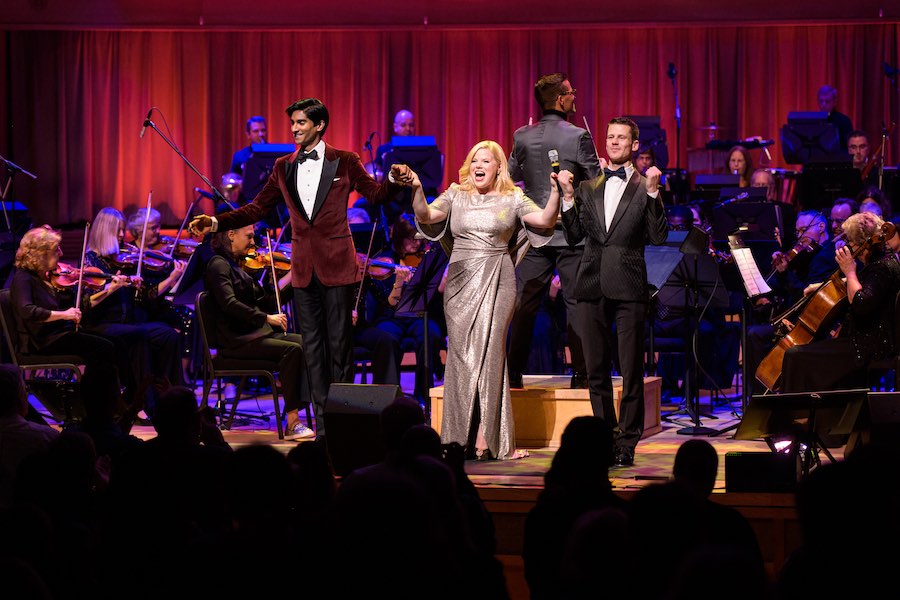Broadway has seized center stage in the DC theater scene since COVID, and thank goodness. We’re seeing major shows like Mean Girls and Wicked stopping in DC on their national tours, the return of the Kennedy Center’s original “Broadway Center Stage” takes on classic shows — featuring major names like Phillipa Soo and Stephanie J. Block — and a perhaps lesser-known form that Broadway can take: concerts. Broadway’s Brightest Lights, staged by the National Philharmonic Orchestra at the Capital One Hall in Tysons, follows through on its promise to “bring the Broadway experience to DC.” The Capital One Hall venue, for those who may not have been there, is unexpectedly, jaw-droppingly gorgeous. It’s in one of those weird standalone tiny microcities that looks vaguely like Cloud City from The Empire Strikes Back, surrounded by highways and Metro stops. Gotta love Northern Virginia.

Broadway’s Brightest Lights was conducted by Luke Frazier, founder of the nationally renowned American Pops Orchestra, who has made it his personal and professional mission to “break down barriers between orchestras and audiences” and “bring communities together through the joy of music.” This was also clearly the mission of Broadway’s Brightest Lights: there was no shortage of cross-generational jubilation in the air as the National Philharmonic Orchestra united three major Broadway talents with some of DC’s top musicians for a celebration of the best composers and songs in musical theater history. Megan Hilty, formerly Glinda in Wicked on Broadway; Michael Maliakel, who is currently playing the title role in Aladdin on Broadway; and Luke Hawkins, a virtuoso tap dancer, performer, and choreographer who has performed in Xanadu and Cirque du Soleil, accompanied a full orchestra for what resembled a variety show of Broadway treats.
To boot, the orchestrations of the classic songs performed at the show were apparently created by Frazier himself, which added a personal touch to the performance and sincerity to his enthusiasm as conductor and MC. As Frazier was giddy to emphasize in his commentary between each song, the night placed a particular focus on classic numbers from Broadway’s storied past, including Hilty’s rendition of “Don’t Rain on My Parade” from Funny Girl, Maliakel’s rendition of “Almost Like Being in Love” from Brigadoon, Sondheim’s “Send In the Clowns” featuring NatPhil horn player Michael Hall, and “Ain’t Misbehavin’” with Luke Hawkins tap-dancing alongside a big band sound courtesy of the full orchestra. You don’t see a tap-dancer-slash-full orchestra duet every day.

Standout performances of the night included Hilty’s rendition of “Popular” from Wicked, in which she played Glinda from 2005 to 2009 on Broadway, on tour, and in the show’s Hollywood productions. Hilty’s years of experience playing this role were on full display in her tour-de-force of “Popular” — she transforms from Megan Hilty into Glinda right on stage with no costume change. She pulls hilarious vocal trick after trick — growls, chirps, and giggles — out of the blue every few seconds, making the song a brand-new thrill even for those who may or may not have memorized Kristen Chenoweth’s version down to the pauses. Hilty’s uproarious touches comprehensively demonstrated her comedic prowess and fearsome vocal versatility in one fell swoop. She’s going to be one of my new favorite Broadway performers to explore, and I’m so glad this show introduced me to her.
Maliakel’s vocal talents are astounding — it would be hard to distinguish his voice from Frank Sinatra’s on a recording. He performed multiple classic Broadway ballads about the challenges that love can bring, including “Who Can I Turn To,” which Tony Bennett originally popularized, and “Being Alive,” from Sondheim’s Company — and Frazier’s prefacing the performance with praise of the recent Broadway revival cemented this performance as a celebration of classic musical theater existing in the medium’s present and optimistic for its future. With the combined power of Sondheim’s cathartic lyrics and wrenching melody, the sincerity of Maliakel’s acting, and the excellence of his vocals, the song soared. Both Maliakel and Hilty used their Broadway acting skills to tell stories with their vocals and physicality, which gave their renditions a uniquely immersive quality. And Luke Hawkins’ tap dancing feels otherworldly — to be able to simultaneously dance and make intricate yet expressive music is a feat indeed.
Roger Ebert once said that you know a show is good if you forget your social security number and where your car is parked halfway through — this happened for me during “Popular,” “Being Alive,” and each of Hawkins’ performances. Good thing I Ubered.
This show also, to its credit, made me realize how much more I have to learn about musical theater. I was familiar with the majority of the songs, but not as familiar with the history of the musicals that Luke Frazier used to preface each number. This show’s unique celebration of Broadway history and the fascinating details I was continually presented with made me crave more of an organization of the night’s performances — chronologically, topically, or what have you. The night’s audience program itself listed the songs in alphabetical order, which made it difficult for me to parse out what the intention behind the show’s song order may have been.
From my box seat on the upper level of Capital One Hall, I could see that a significant portion of the theater was empty. I found myself thinking of all my friends who I wish could have been in attendance to be as touched and wildly entertained by these performances as I was.
Luke Frazier mentioned during one of his inter-song commentaries that if we, the audience, enjoyed this integration of the National Philharmonic Orchestra and Broadway, then they’d do more of it. Sir, I enjoyed it very much. Please do more of it.
Running Time: Approximately 80 minutes with no intermission, plus optional 20-minute talkback.
Broadway’s Brightest Lights presented by the National Philharmonic Orchestra performed on November 4, 2022, at Strathmore Music Center and November 6 at Capital One Hall.




